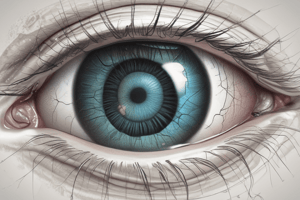Podcast
Questions and Answers
What is the primary cause associated with senile cataracts?
What is the primary cause associated with senile cataracts?
- Penetrating wounds
- Exposure to high doses of radiation
- Poor nutrition
- Aging process (correct)
How should eye drops be administered for effective delivery?
How should eye drops be administered for effective delivery?
- Force drops directly into the eye
- Touch the dropper to the eye lashes
- Rest the thumb on the forehead to stabilize the hand (correct)
- Squeeze the eyes tightly after application
Which of the following is a risk factor for developing cataracts?
Which of the following is a risk factor for developing cataracts?
- High intake of antioxidants
- Regular exercise
- Low exposure to sunlight
- Obesity (correct)
What is a characteristic of traumatic cataracts?
What is a characteristic of traumatic cataracts?
Which condition is the 3rd leading cause of blindness?
Which condition is the 3rd leading cause of blindness?
What happens to the lens in senile cataracts?
What happens to the lens in senile cataracts?
Which of the following is NOT a common identifiable cause of cataracts?
Which of the following is NOT a common identifiable cause of cataracts?
Which symptom is primarily associated with cataracts?
Which symptom is primarily associated with cataracts?
Which demographic factor is NOT a risk factor for glaucoma?
Which demographic factor is NOT a risk factor for glaucoma?
What is the primary characteristic of open-angle glaucoma?
What is the primary characteristic of open-angle glaucoma?
What typically causes acute angle closure in glaucoma?
What typically causes acute angle closure in glaucoma?
Which clinical manifestation is associated with increased intraocular pressure (IOP)?
Which clinical manifestation is associated with increased intraocular pressure (IOP)?
What happens to the nasal fibers of each eye at the optic chiasm?
What happens to the nasal fibers of each eye at the optic chiasm?
Which part of the eye is primarily responsible for the major refractive change of light entering the eye?
Which part of the eye is primarily responsible for the major refractive change of light entering the eye?
What results from untreated acute angle closure glaucoma?
What results from untreated acute angle closure glaucoma?
What role do the ciliary muscles play in near vision?
What role do the ciliary muscles play in near vision?
What is a common diagnostic evaluation method for glaucoma?
What is a common diagnostic evaluation method for glaucoma?
Which condition is characterized by hazy appearing cornea and significant pain due to increased IOP?
Which condition is characterized by hazy appearing cornea and significant pain due to increased IOP?
What is the function of the optic tract?
What is the function of the optic tract?
How does bilateral vision contribute to visual perception?
How does bilateral vision contribute to visual perception?
Which of the following is not considered a risk factor for glaucoma?
Which of the following is not considered a risk factor for glaucoma?
What happens to light rays when they enter the eye?
What happens to light rays when they enter the eye?
Which structure assists in the adjustment of pupil size for near vision?
Which structure assists in the adjustment of pupil size for near vision?
What type of information does the lateral geniculate body process?
What type of information does the lateral geniculate body process?
What is the primary composition of the pinna?
What is the primary composition of the pinna?
What is the function of ceruminous glands in the ear?
What is the function of ceruminous glands in the ear?
Which structure separates the middle ear from the outer ear?
Which structure separates the middle ear from the outer ear?
What is the shape of the external acoustic meatus?
What is the shape of the external acoustic meatus?
What type of epithelium lines the middle ear cavity?
What type of epithelium lines the middle ear cavity?
Where does the pharyngotympanic tube extend to from the middle ear?
Where does the pharyngotympanic tube extend to from the middle ear?
What structures are found on the medial wall of the middle ear?
What structures are found on the medial wall of the middle ear?
What is the primary function of the funnel shape of the external ear?
What is the primary function of the funnel shape of the external ear?
What is a potential benefit of pupil dilation for individuals with cortical cataracts?
What is a potential benefit of pupil dilation for individuals with cortical cataracts?
Which of the following symptoms is NOT associated with cataracts?
Which of the following symptoms is NOT associated with cataracts?
What is the primary method used to diagnose cataracts?
What is the primary method used to diagnose cataracts?
Which surgical technique is commonly used for the removal of cataracts?
Which surgical technique is commonly used for the removal of cataracts?
What role do medications play in the management of cataracts?
What role do medications play in the management of cataracts?
What is the purpose of the A-Scan test before cataract surgery?
What is the purpose of the A-Scan test before cataract surgery?
Which method uses ultra-sonic vibration to break up the lens during cataract surgery?
Which method uses ultra-sonic vibration to break up the lens during cataract surgery?
What preoperative measure is typically taken to enhance patient comfort during cataract surgery?
What preoperative measure is typically taken to enhance patient comfort during cataract surgery?
Flashcards are hidden until you start studying
Study Notes
Vision Pathway
- Optic nerves from each eye converge at the optic chiasm, where nasal fibers cross to the opposite brain side.
- Temporal retina fibers remain uncrossed, with visual fields directed as follows:
- Right visual field (left half of each eye) to the left occipital lobe.
- Left visual field (right half of each eye) to the right occipital lobe.
- Beyond the optic chiasm, fibers are termed optic tracts, continuing to the lateral geniculate body in the thalamus.
- Visual information is then transmitted through optic radiation to the occipital lobe.
Physiology of Vision
- Light refraction occurs primarily at the cornea, with the lens enabling fine focusing.
- Accommodation adjusts lens shape for distance viewing, controlled by ciliary muscle contraction for near vision.
- The iris constricts the pupil to optimize light entry, also protecting against bright light.
- Photoreceptors on the retina convert light into electrical impulses sent via the optic nerve to the lateral geniculate body, facilitating bilateral vision for depth perception.
Glaucoma Risk Factors
- Family history, African American race, older age, diabetes, cardiovascular disease, migraine syndrome, nearsightedness, eye trauma, and corticosteroid use increase glaucoma risk.
Classification of Glaucoma
- Open-Angle Glaucoma: Most common type, characterized by gradual vision loss due to increased intraocular pressure (IOP) and optic nerve degeneration.
- Closed-Angle (Angle-Closure) Glaucoma: Occurs with obstruction at the trabecular meshwork, leading to sudden IOP elevation and potential eye damage.
Pathophysiology of Glaucoma
- Shallow anterior chambers are prone to blockage, leading to aqueous humor accumulation and increased IOP.
- Acute angle closure due to pupil dilation or iris displacement can cause rapid IOP spikes, potentially resulting in permanent damage.
Clinical Manifestations of Glaucoma
- Symptoms include eye pain, rainbow halos around lights, blurred vision, dilated pupils, corneal edema, nausea, vomiting, and excessive tearing.
Diagnostic Evaluation for Glaucoma
- Tonography measures IOP and drainage resistance.
- Drops should be applied carefully without contacting the eye surface to avoid contamination.
Complications of Glaucoma
- Potential outcomes include vision loss and blindness.
Cataracts Overview
- Cataracts lead to lens cloudiness and are a leading cause of blindness, often presenting unilaterally or bilaterally.
Classification of Cataracts
- Senile Cataracts: Associated with aging; UV radiation exposure is a risk factor.
- Traumatic Cataracts: Result from eye injuries.
- Congenital Cataracts: Present at birth.
- Secondary cataracts may arise from eye diseases or systemic conditions, like diabetes.
Risk Factors for Cataracts
- Age: Increased incidence after age 65.
- Other factors include gender, radiation exposure, corticosteroid use, poorly controlled diabetes, and lifestyle factors like nutrition and smoking.
Pathophysiology of Cataracts
- Senile cataracts are characterized by changes in lens protein, increased sodium, and water accumulation disrupting lens fibers.
Clinical Manifestations of Cataracts
- Symptoms consist of blurred vision, glare from lights, gradual vision loss, and cloudy lens appearance.
Diagnostic Tests for Cataracts
- Diagnosis occurs via direct lens inspection with an ophthalmoscope after pupil dilation.
- Additional tests like A-scan, keratometry, and endothelial cell counts evaluate eye health pre-surgery.
Management of Cataracts
- Medications are ineffective; surgery is the primary treatment.
- Typical surgical approach includes extraocular cataract extraction techniques like irrigation, aspiration, or phacoemulsification.
Ear Anatomy
- The ear consists of three parts: external ear (pinna), middle ear (tympanic cavity), and inner ear.
- The pinna, made of cartilage, helps channel sound to the tympanic membrane.
- The external auditory tube includes ceruminous glands that produce earwax for canal protection.
Middle Ear Structure
- An air-filled cavity lined with epithelium, located in the temporal bone.
- Key features include the tympanic membrane, openings to the mastoid antrum, and the pharyngotympanic tube connecting to the nasopharynx.
Studying That Suits You
Use AI to generate personalized quizzes and flashcards to suit your learning preferences.





